 First were the bushes planted at 150 yards. Then came the 150-yard stakes. Then the yardages engraved on sprinkler heads. Then colored circles and lines painted on cart paths. And of course, finally, detailed yardage books. Now technology has come to the rescue with amazingly accurate laser range finders and GPS systems.
First were the bushes planted at 150 yards. Then came the 150-yard stakes. Then the yardages engraved on sprinkler heads. Then colored circles and lines painted on cart paths. And of course, finally, detailed yardage books. Now technology has come to the rescue with amazingly accurate laser range finders and GPS systems.
With the “information age” of golf yardages decidedly upon us, the USGA and R&A relented last year and agreed to make modern distance finders legal for handicapping and tournament play subject to the enactment of local rules permitting them. Huzzah! But wait… they quickly followed up with an “Oh, by the way…”
The “by the way” was, of course, a “clarification” to the new decision (14-3/0.5) issued March 1 that prohibits the devices from displaying anything but yardages. So range finders or other gadgets that calculate slope, wind speed or direction, or give compass headings remain forbidden for handicapping or tournament play.
The ban holds true even if those functions are not used. Which is too bad since many golfers had already invested in the more full-featured devices anticipating the rules change. So what’s legal today? Here’s a look at some of the current array of yardage measuring devices that fit the USGA and R&A criteria:
GPS Systems
GPS systems are smaller and lighter than range finders and don’t require a clear line of sight to a target to deliver yardages. Walk to the ball, look at the screen, bingo – you have the yardage. They also deliver yardages to targets difficult to “zap” with a range finder like the front and back of a green.
But there are disadvantages. The course must be pre-mapped either manually or downloaded from a website at the cost of a nominal annual subscription. They don’t show precise yardages to the flagstick. Accuracy depends on the strength of the satellite signal and can be affected by cloud or tree cover. And Mac users are not supported, although I had success using Virtual PC. Here are two examples:
SkyCaddie
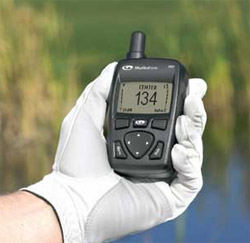 Thanks to the ubiquitous infomercials on The Golf Channel, the SkyCaddie is well known to most golfers. The Sand Trap’s extensive review can be found here. SkyCaddie’s best feature may be what they call “IntelliGreens” which delivers an image of the green outline that rotates depending on your position. A moving cursor then can be placed at approximate flagstick locations to show more precise distances to the target.
Thanks to the ubiquitous infomercials on The Golf Channel, the SkyCaddie is well known to most golfers. The Sand Trap’s extensive review can be found here. SkyCaddie’s best feature may be what they call “IntelliGreens” which delivers an image of the green outline that rotates depending on your position. A moving cursor then can be placed at approximate flagstick locations to show more precise distances to the target.
Unfortunately, this feature, as well as distances to hazards and lay-up areas is only available on what they call “4-Star SkyCourses” that have been professionally mapped. Most courses in their database, and those you map yourself, only deliver distances to the front, center, and back of the green. The SkyCaddie weighs a scant 4.2 ounces and has a black and white screen visible in bright light. It retails for $349.99 and is available at various online retailers. Annual subscriptions run from $20 to $60.
SureShot GPS
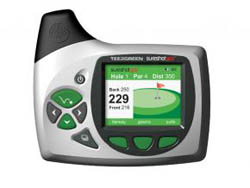 The SureShot GPS system is a newer entry into the GPS market. Made by an Australian company called Tee2Green Technologies, it has nowhere near the number of pre-mapped courses here in the U.S. that the SkyCaddie does. Only about 150 U.S. courses have been mapped. But there are some positive differences.
The SureShot GPS system is a newer entry into the GPS market. Made by an Australian company called Tee2Green Technologies, it has nowhere near the number of pre-mapped courses here in the U.S. that the SkyCaddie does. Only about 150 U.S. courses have been mapped. But there are some positive differences.
It has a nifty color screen and holds 10 courses instead of SklyCaddie’s five (although more can be stored on their website). Its biggest advantage is that you can pre-map a course yourself to include distances and carry for up to 15 hazards and bunkers per hole. It also includes a scorekeeping feature that, in conjunction with software they supply, lets you track your game statistics. While no weight is listed, it appears it can’t be much heavier than the SkyCaddie. It retails for $399 from their website and from a growing number retailers and courses here in the U.S.
Laser Range Finders
While much bulkier and heavier than the GPS units, laser range finders are also more precise. Anything you can accurately target in the crosshairs can be measured. And they obviously work on any course you’re on without having to download from a website or pre-map the layout. Here’s a look at some of the available high-end legal yardage-only laser range finders now on the market:
Bushnell PinSeeker 1500
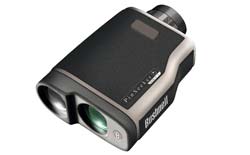 The Busnell PinSeeker 1500 is probably the most popular model today and may well represent the gold standard. The Sand Trap’s review of the same model with the slope feature can be found here. Strapped to the bags of many PGA Tour pros during practice rounds, it is powered by a 9-volt battery and weighs 11.9 ounces. It has a range of 5 to 1,500 yards and up to 400 yards for flagsticks. It also has 7x magnification and is waterproof. It retails for $399.
The Busnell PinSeeker 1500 is probably the most popular model today and may well represent the gold standard. The Sand Trap’s review of the same model with the slope feature can be found here. Strapped to the bags of many PGA Tour pros during practice rounds, it is powered by a 9-volt battery and weighs 11.9 ounces. It has a range of 5 to 1,500 yards and up to 400 yards for flagsticks. It also has 7x magnification and is waterproof. It retails for $399.
Nikon 500G LaserCaddy
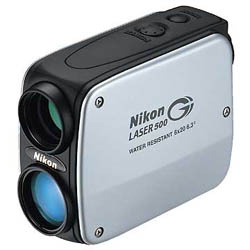 The Nikon 500G LaserCaddy is lighter at just 8 ounces thanks to its CR-2 lithium battery. It’s also smaller, measuring 3.7×2.8×1.6 inches. Its range is 11 to 500-plus yards with 6x magnification. It has a high contrast LCD display and adjustable eyepiece. Unlike the Busnell 1500, it is not waterproof, only water resistant. List price is $464.95.
The Nikon 500G LaserCaddy is lighter at just 8 ounces thanks to its CR-2 lithium battery. It’s also smaller, measuring 3.7×2.8×1.6 inches. Its range is 11 to 500-plus yards with 6x magnification. It has a high contrast LCD display and adjustable eyepiece. Unlike the Busnell 1500, it is not waterproof, only water resistant. List price is $464.95.
Leica PinMaster
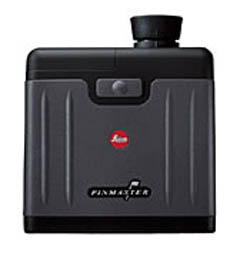
The Leica PinMaster Laser Rangefinder carries one of the most respected brand names in optics – and a price to match. Weighing in at 11.25 ounces with its 9-volt battery, it has 7x magnification with a range of 700 yards, 300 yards to the flagstick. Which means it might have limited usefulness for Tiger, J.B. Holmes or Bubba Watson on short par 4s. But with Leica optics, you can bet the image is clear. Like the Bushnell, it comes with a carrying case and retails for a cool $600.
NewCon Optik LRM 1200
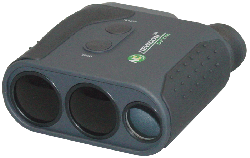 The NewCon Optik LRM 1200 trades a lower price for more weight. At 14.8 ounces with a 9-volt battery it has a range of 20 to 1,200 meters, 7x magnification and retails for $299. It also has a memory function that can recall the last 10 readings made. It is not waterproof or water resistant.
The NewCon Optik LRM 1200 trades a lower price for more weight. At 14.8 ounces with a 9-volt battery it has a range of 20 to 1,200 meters, 7x magnification and retails for $299. It also has a memory function that can recall the last 10 readings made. It is not waterproof or water resistant.
LaserLink QuickShot
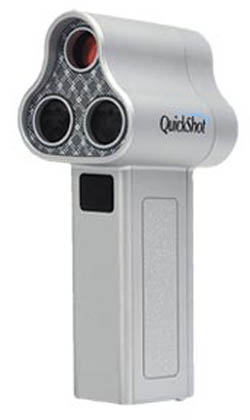 The LaserLink QuickShot rangefinder is endorsed by Arnold Palmer and Jack Nicklaus. That’s the good news. The bad news is that it can only be used on courses where special reflectors have been installed on the flagsticks. Right now, only 700 of the 14,000+ courses in the U.S. are so equipped. But don’t give up on them yet. The same executives who made SoftSpikes mandatory on virtually every course in the country are also behind the Laser Link system and they’re working to do the same in the distance measuring market. The unit is powered by a 9-volt battery and is accurate from 30 to 300 yards. It is sold only at courses equipped with the Laser Link reflectors and retails for $279.
The LaserLink QuickShot rangefinder is endorsed by Arnold Palmer and Jack Nicklaus. That’s the good news. The bad news is that it can only be used on courses where special reflectors have been installed on the flagsticks. Right now, only 700 of the 14,000+ courses in the U.S. are so equipped. But don’t give up on them yet. The same executives who made SoftSpikes mandatory on virtually every course in the country are also behind the Laser Link system and they’re working to do the same in the distance measuring market. The unit is powered by a 9-volt battery and is accurate from 30 to 300 yards. It is sold only at courses equipped with the Laser Link reflectors and retails for $279.
In the End…
Are any of these devices worth the investment? That’s a hard call. They do save some time calculating yardage and they can be incredibly accurate. Ultimately they give feedback on how far you hit various clubs in different conditions and that can be critically helpful to improve your scoring. But for now, with just a few exceptions, don’t look for many organizations to allow them in tournament play. Where I play, the Metropolitan and New Jersey Golf Associations have both decided to follow the lead of the USGA and not allow them in competitions. But that didn’t stop a gadget freak like me from putting one in my bag.

A couple of corrections regarding the SkyGolf Sky Caddie. The device will hold 10 courses and five that you personally map. Mapping the front, center, and back of a green is relatively easy and quick. You could do it during a round of golf, if the course isn’t busy and people aren’t waiting to hit. You may be able to map hazards also, but that starts to get complicated and probably can’t be done during a round. The course had to allow someone from Skygolf “professionally” map the course which includes the outline of the green.
I have not used a laser finder, but have had the Sky Caddie for one season. I highly recommend it. I have found it to be accurate and extremely helpful. Especially approaching greens and knowing front and back edges. If I know the club I have can’t reach the back of the green, then I can swing away with confidence and not hold back. Quite helpful. That is just one example. Knowing the distance to a hazard AND the carry distance also helps in making good course management decisions. I would recommend them to anyone. I am a 10.
Mallard: Good point on the 10 courses that the SkyCaddie will hold. But to clarify further, the SkyCaddie will hold five courses that you program yourself and five that you have downloaded from their website. If you don’t subscribe to the service, you are limited to the five courses you can enter yourself. I too find the SkyCaddie useful. In fact, during my last round my cart mate was using a rangefinder. By the end of the round, he put it away and was using my SkyCaddie.
Our club was evaluation the two GPS systems and while I personally very much prefer the sureshot, the bottom line is that the sky caddie database is vastly superior. It’s a great selling feature for the Pro Shop to be able to tell a potential buyer that they can upload a course they are planning to play on their business trip.
I suspect within 18 months the differences will be much less. The scoring feature and game analysis is also very slick (for a gadget geek golfer.)
You guys are the 60170 best, thanks so much for the help.
Anyone here know how many laser units and golf GPS units were sold last year? Growth rates moving forward? I work for a golf course developer and he doesn’t believe in the devices and doesn’t believe they’ll gain much traction. I disagree and want to rent/sell them via the ProShop and was hoping to persuade him with some numbers. Thx!
Do you guys know anyone in the Orlando area that could rent me a Golf GPS for a couple of days. Specifically, Jan. 17th & 18th 2010?